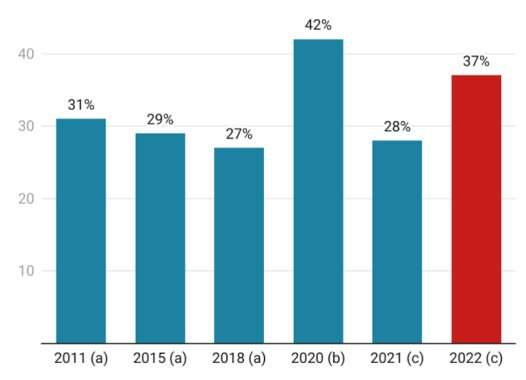Food insecurity trends among low-income households (<300% FPL) in Los Angeles County over time. Source of data: a Los Angeles County Health Survey, USDA Short Form Food Insecurity Module; b Understanding America Study, Food Insecurity Experience Scale; c Understanding America Study, USDA Short Form Food Insecurity Module (LAC DPH, 2021). Credit: https://publicexchange.usc.edu/wp-content/uploads/2023/02/USC-Food-Insecurity-in-LA-County_ResearchBrief_Feb2023.pdf
In March, nearly 1.4 million CalFresh beneficiaries in Los Angeles County will receive their final pandemic-era boost intended to help make food more affordable for low-income people. Every household will receive at least $95/month less, and some could see reductions of as much as $250/month.
The expiration of the three-year-long supplement to the federal program, known as SNAP in other states (and formerly known as "food stamps"), coincides with new research findings revealing that last year, more than one in three (37%) of low-income residents of L.A. County experienced food insecurity. That's 10 percentage points higher than in 2018 and just 5 points shy of the early pandemic rate of 42% in 2020.
Food insecurity is defined as a lack of access to enough food to live a healthy, active life.
The study, published by the USC Dornsife College of Letters, Arts and Sciences' Public Exchange, also determined that about 1 in 4 of all Angelenos, or approximately 800,000 households, experienced food insecurity in 2022.
"After a dip in 2021, food insecurity clearly worsened last year. The expiration of the emergency boost to the CalFresh program, while inflation and food costs remain high, could push low-income Angelenos to the precipice of a 'hunger cliff,'" said Kayla de la Haye, the lead researcher and associate professor of population and public health sciences at Keck School of Medicine of USC.
As one Latina mother explained to researchers in December 2022: "[During the pandemic] that was my fear, that [my children] didn't have enough. I started skipping a meal to make sure they were fed. And it's worse now. Because the bills went so [high]. And it's kind of scary."
Women, young adults, and Latino and Black residents were disproportionately impacted by food insecurity in L.A. County in 2022, with rates of food insecurity three times higher among Latino (33%) and Black (33%) Angelenos than white residents (11%). Additionally, more than 4 in 10 food-insecure households have children.
The CalFresh program was created to improve the health and well-being of low-income Californians through financial assistance that can be used to buy food at many markets and food stores. The emergency boost in benefits was introduced in March 2020.
The study findings are based on data from a representative sample of more than 1,000 L.A. County residents who participate in the USC Dornsife Understanding America Study.
L.A.'s Eastside: Many grocers—few affordable, quality options
A related study led by de la Haye and coordinated by USC Dornsife's Public Exchange evaluated access to food by residents of Boyle Heights, Lincoln Heights, El Sereno and City Terrace—eastside neighborhoods designated "food deserts" by the U.S. Department of Agriculture.
The researchers determined that contrary to what the "food desert" label suggests, those neighborhoods have 269 retail outlets that sell groceries. Nine in 10 households had access to six or more stores selling groceries within a 15-minute walk of their home. A lack of access to food stores, which is a contributor to food insecurity and health, wasn't a top concern for residents—however high prices, low quality food and a limited variety of healthy items were.
"The stores in my neighborhood are small and a little pricey," said one eastside resident. "But if you need something immediate, this is where you come. … Sometimes the vegetables go bad quickly, faster than other companies."
Many in the predominately Latino neighborhoods said they had to go to multiple stores to get the type and quality of groceries they want, which adds time and transportation challenges. They also said they'd like to see existing stores provide better access to a wider variety of food that is healthy, high-quality, organic and affordable.
To address the issues they identified, the researchers include several recommendations in their study report:
- Leverage existing programs, or develop new programs and initiatives, to improve the quality, variety and healthfulness of foods.
- Identify more opportunities to make high-quality, organic, healthy foods more affordable. For example, expand subsidies and enrollment in government food programs like CalFresh and Market Match, and help local grocers get set up to accept them.
- Tailor strategies to improve access to groceries to households that need it most. .
- Expand community programs that can supplement healthy food access and strengthen a culture of healthy eating and well-being.
Provided by University of Southern California
























